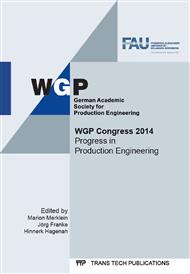[1]
H. Uetz, Einfluss der Honbearbeitung von Zylinderlaufbüchsen auf die innere Grenzschicht und den Einlaufverschleiß, Forschungsbericht 215/l- 1, FVV, Heft 85 (1968).
Google Scholar
[2]
W. Mach, Tribomutation bei der Endbearbeitung und ihre Auswirkungen auf das tribologische Verhalten während des Betriebes, University of Karlsruhe, Diss., (2003).
Google Scholar
[3]
P. Berlet, Einfluss spanender Endbearbeitungen mit geometrisch unbestimmten Schneiden auf tribologische Funktionsflächen im Motorenbau sowie auf Reibung und Verschleiß, University of Kassel, Diss., (2009).
Google Scholar
[4]
M. Scherge, A. Gervé and P. Berlet, Tribomutation von Werkstoffflächen im Motorenbau am Beispiel des Zylinderzwickels, 2. Abschlussbericht, FVV-Vorhaben 716 (2001).
Google Scholar
[5]
B. Kehrwald, Untersuchung der Vorgänge in tribologischen Systemen während des Einlaufs, University of Karlsruhe, Diss., (1998).
Google Scholar
[6]
J. Böhm, M. Michel, T. Behr, M. Hahn and S. Schweickert, Nanoslide - Die Weiterführung der konsequenten Optimierung von Zylinderlaufbahnen bei Mercedes Benz, VDI-Berichte 2163 Zylinderlaufbahn, Kolben, Pleuel (2012), S. 141-158.
Google Scholar
[7]
L. Sabri, S. Mezghani, M. El Mansori, A study on the influence of bond material on honing engine cylinder bores with coated diamond stones, Surface and Coatings Technology, Volume 205, Issue 5 (2010), S. 1515-1519.
DOI: 10.1016/j.surfcoat.2010.10.016
Google Scholar
[8]
I. Buj-Corral, J. Vivancos-Calvet, Roughness variability in the honing process of steel cylinders with CBN metal bonded tools, Precision Engineering, Volume 35, Issue 2 (2011), S. 289-293.
DOI: 10.1016/j.precisioneng.2010.11.004
Google Scholar
[9]
M. Sabeur, D. Ibrahim, E. -M. Mohamed, Z. Hassan, Energy efficiency optimization of engine by frictional reduction of functional surfaces of cylinder ring-pack system, Tribology International, Volume 59 (2013), S. 240-247.
DOI: 10.1016/j.triboint.2012.01.015
Google Scholar
[10]
B. Goeldel, J. Voisin, D. Dumur, M. El Mansori, M. Frabolot, Flexible right sized honing technology for fast engine finishing, CIRP Annals - Manufacturing Technology, Volume 62, Issue 1 (2013), S. 327-330.
DOI: 10.1016/j.cirp.2013.03.075
Google Scholar
[11]
B. Karpuschewski, H. -J. Pieper, F. Welzel and K. Risse: Alternative strategies in finishing cylinder running surfaces, CIRP Annals - Manufacturing Technology 61/1 (2012), S. 559-562.
DOI: 10.1016/j.cirp.2012.03.119
Google Scholar
[12]
B. Zhmud, U. Morawitz, Enhancing the tribological properties of cylinder bores by mechanochemical surface finishing, VDI-Berichte 2230 Zylinderlaufbahn, Kolben, Pleuel (2014), S. 255-268.
Google Scholar
[13]
M. v. Gradowski, Charakterisierung von plasmafunktionalisierten Oberflächen mittels ToF-SIMS und multivariaten Analysemethoden, University of Mainz, Diss., (2006).
Google Scholar
[14]
Z. Dimkovski, L. Bååth, S. Rosén, R. Ohlsson, B. -G. Rosén, Interference measurements of deposits on cylinder liner surfaces, Wear, Volume 270, Issues 3-4 (2011), S. 247-251.
DOI: 10.1016/j.wear.2010.10.066
Google Scholar


